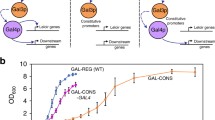Abstract
The artificial gene coding for anticoagulant hirudin was placed under the control of theGAL10 promoter and expressed in the galactokinase-deficient strain (Δgal1) ofSaccharomyces cereivisiae, which uses galactose only as a gratuitous inducer in order to avoid its consumption. For efficient production of recombinant hirudin, a carbon source other than galactose should be provided in the medium to support growth of the Δgal1 strain. Here we demonstrate the successful use of glucose in the fed-batch fermentation of the Δgal1 strain to achieve efficient production of recombinant hirudin, with a yield of up to 400 mg hirudin/L.
Similar content being viewed by others
References
Markwardt, F. (1982) Pharmacology of hirudin: One hundred years after the first report of anticoagulant agent in medicinal leeches.Biomed. Biochem. Acta 44: 1007–1013.
Bagdy, D., E. Barabas, L. Graf, T. E. Petersen, and S. Magnusson (1976) Hirudin.Methods Enzymol. 45: 669–678.
Markwardt, F., J. Hauptmann, G. Nowak, C. Klessen, and P. Walsman (1985) Pharmacological studies on the antithrombin action of hirudin in experimental animals.Thromb. Haemostasis 47: 226–229.
Markwardt, F. (1989) Development of hirudin as an antithrombotic agent.Sem. Thromb. Homeostatis. 15: 269–282.
Sohn, J. H., H. A. Kang, K. Jagannadha Rao, E. S. Choi, B. H. Chung, C. H. Kim, and S. K. Rhee (2001) Current status of the anticoagulant hirudin: Its biotechnological production and clinical practice.Appl. Microbiol. Biotechnol. 57: 606–613.
Sohn, J. H., S. K. Lee, E. S. Choi, and S. K. Rhee (1991) Gene expression and secretion of the anticoagulant hirudin inSaccharomyces cerevisiae.J. Microbiol. Biotechnol. 1: 266–273.
Khuri, A. I. and A. Cornell (1987) Statistics: Text books and monographs. pp. 32–54. In: D. B. Cowen, R. G. Cornell, A. M. Kshirsagar, W. J. Kennedy and E. G. Schilling (eds.)Response Surfaces Designs and Analyses. Marcel Dekker, Inc., New York, USA.
Lee, D. H., J. H. Seo, J. H. Sohn, E. S. Choi, and S. K. Rhee (1994) Optimization of environmental conditions for hirudin production from recombinantSaccharomyces cerevisiae.Korean J. Biotechnol. Bioeng. 9: 8–15.
Sohn, J. H., E. S. Choi, B. H. Chung, D. J. Youn, J. H. Seo, and S. K. Rhee (1995) Process development for the production of recombinant hirudin inSaccharomyces cerevisiae: from upstream to downstream.Proc. Biochem. 30: 653–660.
Jagannadha Rao, K., C. H. Kim, and S. K. Rhee (2000) Statistical optimization of medium for the production of recombinant hirudin fromSaccharomyces cerevisiae using response surface methodology.Process Biochem. 35: 639–647.
Ko, S. M. (2001)Secretion of Recombinant Human Serum Albumin in Saccharomyces cerevisiaeStrain Lacking Galactokinase Encoded by Gal1. M. S. Thesis, Chungnam National University, Daejeon, Korea.
Choi, E. S., J. H. Sohn, and S. K. Rhee (1994) Optimization of the expression system using galactose inducible promoter for the production of anticoagulant hirudin inSaccharomyces cerevisiae.Appl. Microbiol. Biotechnol. 42: 587–594.
Jagannadha R. K., C. H. Kim, B. H. Chung, M. K. Kim, and S. K. Rhee (1999) Suppression of proteolytic degradation of recombinant hirudin fromSaccharomyces cerevisiae using the oxygen enriched air.Biotechnol. Lett. 21, 391–394
Jagannadha R. K., C. H. Kim, B. H. Chung, J. H. Sohn, and S. K. Rhee (1998) Effect of galactose feeding on the improved production of hirudin in fed-batch cultures of recombinantSaccharomyces cerevisiae.Bioprocess Eng. 19: 385–388.
Author information
Authors and Affiliations
Corresponding author
Rights and permissions
About this article
Cite this article
Ramisetti, S., Kang, H.A., Rhee, S.K. et al. Production of recombinant hirudin in galactokinase-deficientSaccharomyces cerevisiae by fed-batch fermentation with continuous glucose feeding. Biotechnol. Bioprocess Eng. 8, 183–186 (2003). https://doi.org/10.1007/BF02935894
Received:
Accepted:
Issue Date:
DOI: https://doi.org/10.1007/BF02935894




